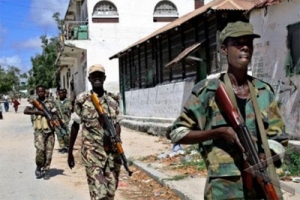
A tsunami victim looks for family photos in a room of personal belongings salvaged from the ruins in Yamada town, Iwate Prefecture in northern Japan on March 26, 2011.— Reuters pic
TOKYO, March 27 — Japanese engineers struggled today to pump radioactive water from a crippled nuclear power station while the world's chief nuclear inspector said the country was "still far from the end of the accident".
Radiation levels in the sea off the Fukushima Daiichi plant have soared to 1,250 times normal just over two weeks after it was battered by a huge earthquake and a tsunami, but it was not considered a threat to marine life or food safety, the Nuclear and Industrial Safety Agency said.
"Ocean currents will disperse radiation particles and so it will be very diluted by the time it gets consumed by fish and seaweed," said Hidehiko Nishiyama, a senior agency official.
The crisis at the plant, 240km north of Tokyo, has overshadowed a relief and recovery effort from the magnitude 9.0 quake and the huge tsunami it triggered on March 11 that left more than 27,100 people dead or missing in northeast Japan.
Yukiya Amano, the director general of the International Atomic Energy Agency (IAEA), cautioned that Japan's nuclear emergency could go on for weeks, if not months more.
"This is a very serious accident by all standards," he told the New York Times. "And it is not yet over."
Amano, a former Japanese diplomat who made a trip to Japan after the quake, said authorities were still unsure about whether the plant's reactor cores and spent fuel were covered with the water needed to cool them.
He told the newspaper he saw a few "positive signs" with the restoration of some electric power to the plant.
But he said: "More efforts should be done to put an end to the accident," while adding he was not criticising Japan's response.
The IAEA, the UN nuclear watchdog, said it had sent two additional teams to Japan over the past two days, one to help in monitoring radiation and one to assess food contamination.
Prolonged efforts to prevent a catastrophic meltdown at the 40-year-old Fukushima plant have also intensified concern around the world about nuclear power. UN Secretary-General Ban Ki-moon said it was time to reassess the international atomic safety regime.
RADIOACTIVE WATER
Engineers trying to stabilise the plant have to pump out radioactive water after it was found in buildings housing three of the six reactors.
On Thursday, three workers were taken to hospital from reactor No. 3 after stepping in water with radiation levels 10,000 times higher than usually found in a reactor. That raised fear the core's container could be damaged.
An official from plant operator Tokyo Electric Power Co (TEPCO) told a news conference experts still had to determine where to put some of the contaminated water while engineers were still trying to fully restore the plant's power.
Two of the plant's reactors are now seen as safe but the other four are volatile, occasionally emitting steam and smoke. However, the nuclear safety agency said yesterday that temperature and pressure in all reactors had stabilised.
The government has said the situation is nowhere near to being resolved, although it was not deteriorating.
"We are preventing the situation from worsening — we've restored power and pumped in fresh water — and making basic steps towards improvement but there is still no room for complacency," Chief Cabinet Secretary Yukio Edano told a news conference yesterday.
RADIATION LEVELS LOW
At Three Mile Island, the worst nuclear power accident in the United States, workers took just four days to stabilise the reactor, which suffered a partial meltdown. No one was injured and there was no radiation release above the legal limit.
At Chernobyl in Ukraine, the worst nuclear accident in the world, it took weeks to "stabilise" what remained of the reactor that exploded and months to clean up radioactive materials and cover the site with a concrete and steel sarcophagus.
So far, no significant levels of radiation have been detected beyond the vicinity of the plant in Fukushima.
The US Department of Energy said on its website (http://blog.energy.gov/content/situation-japan/) no significant quantities of radiological material had been deposited in the area around the plant since March 19, according to tests on Friday.
In Tokyo, a metropolis of 13 million, a Reuters reading this morning showed ambient radiation of 0.22 microsieverts per hour, about six times normal for the city. That was well within the global average of naturally occurring background radiation of 0.17-0.39 microsieverts per hour, a range given by the World Nuclear Association.
In the city of Yamagata, 110km northwest of Fukushima, the reading was 0.15 microsieverts per hour.
The government has prodded tens of thousands of people living in a 20-30km zone beyond the stricken complex to leave. Edano said the residents should move because it was difficult to get supplies to the area, and not because of elevated radiation.
Kazuo Suzuki, 56, who has moved from his house near the plant to an evacuation centre, said neighbours he had talked to by telephone said delivery trucks were not going to the exclusion zone because of radiation worries.
"So goods are running out, meaning people have to drive to the next town to buy things. But there is a fuel shortage there too, so they have to wait in long queues for gasoline to use the car."
Radiation levels at the evacuation centre were within a normal range of about 0.16 microsievert, according to a Reuters Geiger counter reading.
In Japan's northeast, more than a quarter of a million people remain in shelters, and the impact on livelihoods is becoming clearer. The quake and tsunami not only wiped out homes and businesses, but also a fishing industry that was the lifeblood of coastal communities.
"Fishermen lost their gear, ships and just about everything. About half will probably get out of the business," said Yuko Sasaki, a fishmonger in the tsunami-hit city of Kamaishi. — Reuters
Full Feed Generated by Get Full RSS, sponsored by USA Best Price. 
 Memang pernikahan bukan barang baru bagi Pasha "Ungu". Tapi, ketegangan tetap saja terlihat dari wajahnya.
Memang pernikahan bukan barang baru bagi Pasha "Ungu". Tapi, ketegangan tetap saja terlihat dari wajahnya.




 Sending your message
Sending your message